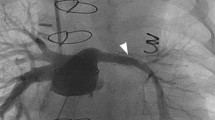Abstract
We carried out a device-needs survey to evaluate the gaps in device and equipment availability for congenital interventional cardiologists. As the complexity and demand for more complete solutions to congenital heart lesions increase, there is a growing need for modification and development of devices and equipment to support this endeavor. The survey was sent out via e-mail to members of the Congenital Cardiovascular Interventional Study Consortium and the Society for Cardiac Angiography and Interventions with a reach of over 350 congenital interventionalists. Responses were received from 68 cardiologists in 8 countries. In terms of the most desired device, 41 % ranked bioresorbable stents as their first choice from a list of 12 possible devices. Similarly, 23 % ranked large covered stents as their first choice. Twenty-seven percent of participants believed bioresorbable stents would have the greatest potential to improve morbidity of their patients, with another 27 % reporting that covered stents would have the greatest impact. Fifty percent of participants reported that they would like to see large covered stents available in their country. These data point toward a perceived need for the development/approval of bioresorbable stents for the pediatric age group, as well as the need to approve the use of large covered stents in the pediatric age group in the USA.




Similar content being viewed by others
References
Feltes TF et al (2011) Indications for cardiac catheterization and intervention in pediatric cardiac disease: a scientific statement from the American Heart Association. Circulation 123(22):2607–2652
Holzer R, Hijazi Z (2008) The off-versus on-label use of medical devices in interventional cardiovascular medicine? Clarifying the ambiguity between regulatory labeling and clinical decision making, part III: structural heart disease interventions. Catheter Cardiovasc Interv 72(6):848–852
Kenny D, Hijazi Z (2015) Bioresorbable stents for pediatric practice: where are we now? Interv Cardiol 7(3):245–255
Gogas BD (2014) Bioresorbable scaffolds for percutaneous coronary interventions. Glob Cardiol Sci Pract 2014(4):409–427
McMahon CJ, Oslizlok P, Walsh KP (2007) Early restenosis following biodegradable stent implantation in an aortopulmonary collateral of a patient with pulmonary atresia and hypoplastic pulmonary arteries. Catheter Cardiovasc Interv 69(5):735–738
McCrossan BA, McMahon CJ, Walsh KP (2014) First reported use of drug-eluting bioabsorbable vascular scaffold in congenital heart disease. Catheter Cardiovasc Interv
Kenny D et al (2011) Innovative resource utilization to fashion individualized covered stents in the setting of aortic coarctation. Catheter Cardiovasc Interv 78(3):413–418
Hijazi ZM, Kenny DP (2014) Covered stents for coarctation of the aorta: treating the interventionalist or the patient? JACC Cardiovasc Interv 7(4):424–425
Zahn EM et al (2015) A novel technique for transcatheter patent ductus arteriosus closure in extremely preterm infants using commercially available technology. Catheter Cardiovasc Interv 85(2):240–248
Bass JL, Wilson N (2014) Transcatheter occlusion of the patent ductus arteriosus in infants: experimental testing of a new Amplatzer device. Catheter Cardiovasc Interv 83(2):250–255
Philip et al (2015) Morphologic characterization of the patent ductus arteriosus in the premature infant and the choice of transcatheter occlusion device. Catheter Cardiovasc Interv
Author information
Authors and Affiliations
Corresponding author
Ethics declarations
Conflicts of interest
None of the authors report a conflict of interest. Tim Moran is the executive director of PediaWorks, a 501.c.3 non-profit organization aimed at developing pediatric-specific devices based on clinical need rather than financial return. He is also the CEO of PediaVascular, a marketer of pediatric cardiology catheters.
Rights and permissions
About this article
Cite this article
Shibbani, K., Kenny, D., McElhinney, D. et al. Identifying Gaps in Technology for Congenital Interventions: Analysis of a Needs Survey from Congenital Interventional Cardiologists. Pediatr Cardiol 37, 925–931 (2016). https://doi.org/10.1007/s00246-016-1372-0
Received:
Accepted:
Published:
Issue Date:
DOI: https://doi.org/10.1007/s00246-016-1372-0




